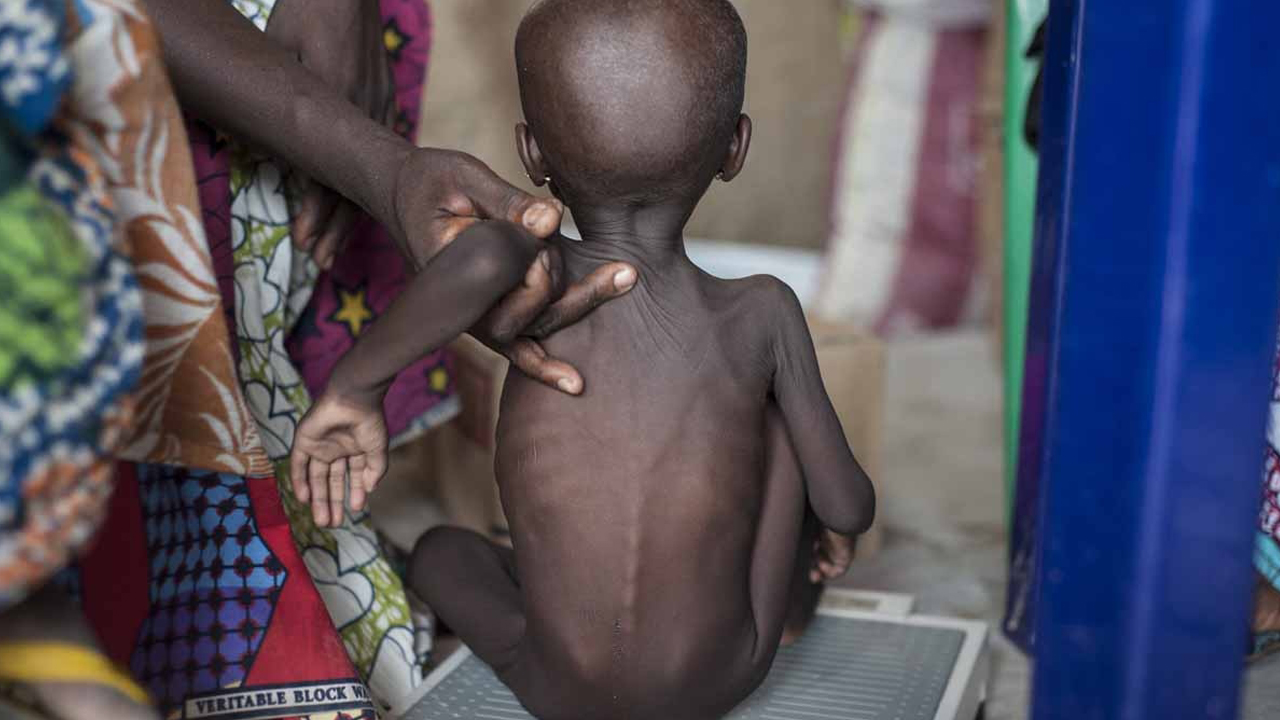The crowd outside the primary health care facility is noisy. The corridors are jam-packed, the atmosphere suffocating. Women and children in all positions: standing, sitting and some even lying down. At the crack of dawn, people start trickling into the PHC and by 8am, the entire building is packed.
Even to the common man, it is easy to decipher what brings these women, clutching children in their arms, to the hospital. The faces of the children are long and thin, with high foreheads, sunken cheeks and eyes pulled deep into their sockets. The hair of the children has lost its shine and has turned from the common jet-black African hair into a sparse reddish-brown mess enveloping their scalp. Their dry scaly skin has an uneven skin tone, dark areas mixed with lighter shades, and is riddled with whitish scales, rash and in some areas, open wounds caused by excessive scratching. The skin, ugly as it, hangs loosely off their protruding bones. Contrary to the nature of children, who would otherwise be running around playing and breaking things, these ones lie weakly in the arms of their mothers, quietly as if they too are waiting patiently for the doctor. The reality, however, is that they simply lack the energy to do otherwise.
Even to the common man, it is easy to see that these children suffer from malnutrition.
Zainab has been coming to the Medecines San Frontiers (MSF) run PHC for the past three months. Her son, Usman is 16-months old and weighs only 8kg. At their initial visit, he weighed 6.5kg and could hardly sit without support. Now, however, he has started to crawl. Zainab lives with her husband and six children in a two-bedroom, rented house in a densely populated ghetto popularly dubbed ‘China’ (no offence intended) in Kano city. Her husband works as a security officer for a company while she braids hair for a living. Three of her children were diagnosed with severe acute malnutrition this year. She was worried about her son, Usman, because his older brother (a three-year-old) had died two months ago after having fever and what she calls ‘limonia’ (pneumonia).
- Malaria as silent killer, major public health concern
- ‘It is sad that despite lives lost during Biafra, Nigeria is still divided’
In medical school, during paediatric rotation, malnutrition was something we frequently encountered. I want to believe that you cannot graduate from medical school in Nigeria and by extension Africa, and not know how to manage malnutrition. Most importantly, we were taught nutritional counseling- the science of calculating calories, deficit and how to make use of our locally available food in order to promote healthy weight gain in children. From our professors, we learnt how to teach mothers to make highly fortified pap from soya beans, millet and groundnut. Fifteen years ago, we used to preach the following: From six months, feed the baby every two hours when he or she is awake. If you cannot afford chicken or beef, then one egg a day, every day. Buy beans and make moimoi, akara or just rice and beans. Butter spread on bread, generously. Make tofu from soya beans and give the child generous portions. If you cannot afford fish, then buy blended crayfish and put in soups. Make vegetable soups and salads for babies over the age of one; green vegetables especially for iron, folic acid and calcium. Mashed potatoes at least thrice a week. Milk in pap with sugar for energy; cocoa beverages if you can afford it. Plenty of whatever fruit was in season for vitamin C. These days however, the nutritional counseling has changed.
At almost N4,000 per mudu, beans is no longer a popular substitute for meat. In fact, it is now more expensive than rice. In the absence of beans and crayfish (our once popular sources of protein), Usman’s mother was told to turn to an increasingly popular snack instead- grasshoppers or crickets (faara). The grasshoppers, when fried and blended, are now being used in many low-income households to provide flavour and nutritional benefit- much like the popular crayfish. Scientists have confirmed that they contain high levels of protein so much so that are now a major ingredient in the fortified pap mixtures sold in stores.
Another shocker was the use of bone stock for calcium. Again, Usman’s mother was told to go to the market and buy discarded bones (that butchers usually sold at a significantly lower price to people who owned dogs) and cook well. The broth was what would be given to the children to drink as it was a rich source of calcium. Bone soup, if I may be so callous.
Eggs of course, are out of the question. It has been replaced by Tofu (awara) to be given to the child daily. Beef, chicken and lamb have since left the group chat.
What about fruits and vegetables, you say? Well, there is no more N50 or N100 worth of lettuce or any fruit slice for that matter, and so it has been cancelled. Instead, we preach eating locally available vegetables like spinach, Moringa (zogale), Ugwu leaves, Rama (Sesame leaves). For fruits, mangoes (the small inexpensive kind, plucked from trees), Malmo (water berries) Kanya (Jackalberry), Agbalumo etc will do the trick.
Far more alarming, however, is not the degree of malnutrition. Indeed, I have seen worse in villages; it is the sheer number of infants presenting to the clinics. Once upon a time, this type of malnutrition was limited to rural hospitals and IDP camps, now however, we are seeing them in urban hospitals and city centers.
Médecins Sans Frontières, also known as Doctors without Borders, commissioned an expansion of a 25-bed capacity Inpatient Therapeutic Feeding Centre in Unguwa Uku Primary Health Centre, Kano State. This is in addition to the previous 50-bed capacity operated in the centre. The MSF Therapeutic Feeding Programme is intended to reduce the mortality rate of severely malnourished individuals within the entire affected population, including children, adolescents, the elderly and adults. Every day, hundreds of women like Zainab flock to this hospital so that their children can access care.
The dedication of MSF is remarkable to note and at the same time, disheartening. Remarkable because of all the wonderful work they are doing and disheartening because like always, we are relying on foreign aid to feed our starving children because we are too poor to do so.
But are we really so poor?
Although, the presidency has kept mum about plans its plan to buy a new presidential jet, rumour has it that the government has already identified an aircraft for purchase, but is yet to finalise the deal as it is scrambling for funds to consummate the transaction. The identified aircraft is said to be a repossessed one recovered from a troubled oil sheikh who used the aeroplane as collateral for a loan he obtained from an unidentified German bank to buy it.
It is an open secret that the aircraft is now in the possession of one ‘L & L International LLC’ an American aviation firm based in Miami, Florida. The firm is trying to help the German bank sell it to the Nigerian government. The multi-engine prestige jet, which has an elaborate VIP configuration, is said to be worth $600 million. Nothing but the best for our presido! What is it the youngsters are calling it these days? Yes, steeze! Nigerians have steeze!
However, the Nigerian government is offering “a little over $100 million”; because, well, we don’t want to appear too extravagant. After all, there are children starving in Nigeria.
Like George Orwell wrote: All animals are equal, but some are more equal than others.
I agree: Poor people get grasshoppers, presidents get jets.

 Join Daily Trust WhatsApp Community For Quick Access To News and Happenings Around You.
Join Daily Trust WhatsApp Community For Quick Access To News and Happenings Around You.

